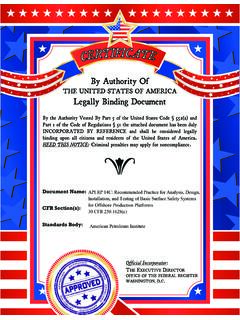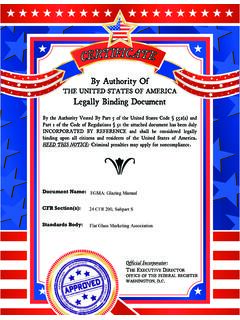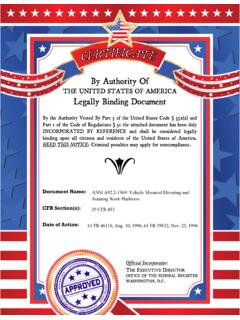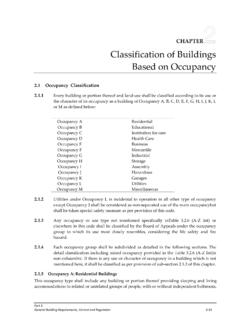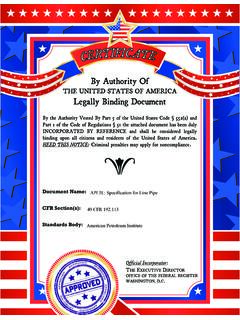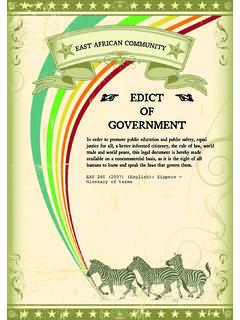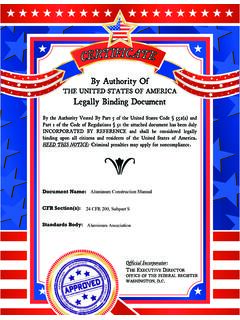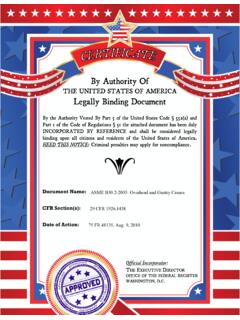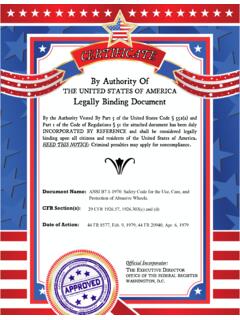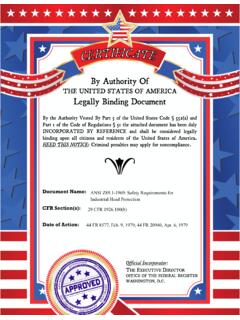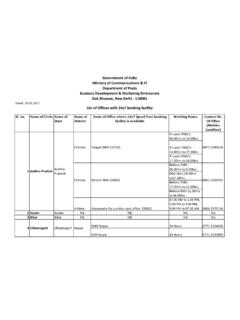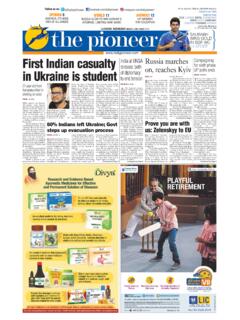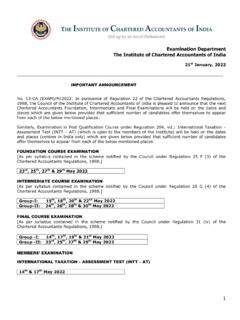Transcription of IS 8130 (1984): Conductors for insulated electric cables ...
1 Disclosure to Promote the Right To InformationWhereas the Parliament of India has set out to provide a practical regime of right to information for citizens to secure access to information under the control of public authorities, in order to promote transparency and accountability in the working of every public authority, and whereas the attached publication of the Bureau of Indian Standards is of particular interest to the public, particularly disadvantaged communities and those engaged in the pursuit of education and knowledge, the attached public safety standard is made available to promote the timely dissemination of this information in an accurate manner to the public. ! $ ' + - Satyanarayan Gangaram Pitroda Invent a New India Using Knowledge 0 1 ' 5 Jawaharlal Nehru Step Out From the Old to the New 1 + , 1 + Mazdoor Kisan Shakti Sangathan The Right to Information, The Right to Live !
2 > 0 B Bhart hari N ti atakam Knowledge is such a treasure which cannot be stolen Invent a New India Using Knowledge IS 8130 (1984): Conductors for insulated electric cablesand flexible cords [ETD 9: Power cables ]IS : 8130 -1984 (Reaffirmed 1996) Indian Standard SPECIFICATION FOR Conductors FOR insulated electric cables ANJD FLEXIBLE CORDS ( First Revision ) .Fiftfi Reprint DECEMgR 1997 UDC [ +669-71 ] : 0 Copyright 1984 BUREAU OF INDIAN STANDARDS MANAK BHAVAN, 9 BAHADUR SHAH ZAFAR MARO NBW DBLIJI 110009 Gr 4 October 1984 IS : 8130 - 1984 Indian Standard SPECIFICATION FOR Conductors FOR insulated ELECTRLC cables AND FLEXlBLE CORDS ( First Revision ) Power cables Sectional Committee, ETDC 59 Chairman SEW M. L. DoNORB M-3, Satyam 88. Sion Circle Bombay Members Representing SJSRI J. P. AQAL Smu B. P. RAI ( Al&mars ) Bharat Heavy Electricals Ltd, Hyderabd SHRI M.
3 R. Bwr Tata Consulting Engineers, Bombay SHRI D. K. BASU ( &fern&c ) CHUEP ENGINEER ( ELIICTRICAL ) I Central Public Works Department, New Delhi SURVEYOR OF WORKS ( Eua ) V ( Aberrlate ) DR K. DAS Gmr~ Calcutta electric Supply torportin (.India ) Ltd, Calcutta SHRI P. NE~CI ( A&rote ) DIRECroR Central Power Research Institute, Bangalore Stutr M. %. RATRA ( Alternate ) Dxaxcro~ OF MINES SAFBIY Directorate General of Mines Safety, D&&ad (Erra) DJRECITX OF MINB SAFETY ( ELECT ) ( Alternate ) SHN RAVI K. Dvrr Cable and Conductor Manufacturers Association of India, New Delhi &RI S. R. SARAN ( Alternote ) SWI P. Gnse Indian Cable Co Ltd. Jamshedpur SHRI K. V. R. RAO ( Afremule ) SHRI hf. M. HONAVAR Cable Corporation of India Ltd, Bombay SIW S. R. PADMANABHAN ( Alrernute ) ( Conrinueff on puge 2 ) @ Copyright 1984 BUREAU OF INDIAN STANDARDS Tbb public&@ is protected under the In&n Copyright Acf ( XIV of 1957 ) rod reproduction in whole or in part by any means except with written permiubll of the aubliahar shall be doamad to be au infringement of copyright under the said Act.
4 ISt8P30-l984 ( Conlinuedfiom page 1 ) hfem&rs Reprrssn~ing SEN D. K. JAIN Directorate of Technical Devolopment & Production ( Air >. New Delhi SHRI V. K. SHARMA ( Alternare ) SHRI K. S. J~~HI Bombay Suburban electric Supply Ltd; Bombay SHRl R. K. SEHGAL ( A~~ ) SHRI S. L. K~KKAR Universal cables ltd. Satna Smu R. C. AORAWAL ( Alternarc ) SHRI RAJ K. MITAL Delhi electric Supply Undertaking, New Delhi SHRI V. K. SALUJA ( Alhwuztc ) SHRI R. V. NARAYANAN Directorate General of .Supplies & Disposala ( Inspection Wing ), New Delhi SHar D. CHANDRA ( AZ&rm~e ) Smu H. M. PAX The Federation of Electricity Undertakings of India, Bombay SMT C. BALIGA ( Almnutc ) SEIU S. N. PARWAL The Premier Cable Co Ltd, Ernakukcr ( Kerala ) SHRI A. K. RAMAN Asian cables Corporation Ltd, Bombay SHRI S. M. SAKEUKAR Bombay electric Supply & Transport Under- taking, Bombay SHR~ S. V. UPASANI ( Akrnare ) SHRI L.)
5 K. SANGHI Fort Gloster Industries Ltd. Howrah SHIU A. S. BHAT~ACIXARJZB ( Alternate ) LT-COL S. R. SEN Controllerate of Inspection Electronics, Bangalore SHRI 9. K. MALHOTRA ( Akernare ) DR M. S. SUKHIJA Punjab Research Institute, Rajpura SHRI U. S. VERMA National Test House, Calcutta SHRI R. RAMAKRISHNA ( ALrrnate ) SHRI K. G. WARMER Oriental Power cables Ltd, Kota SHRI B. K. MUNDHIU ( Alhwuztc ) SHRI S. P. SACHDBV, Director ( Elec tech ) Director General, BlS( Ex-ojicio Member ) S*crrrary SHIU K. M. B~TIA Senior Deputy Director ( Elec tech ), BIS Panel for Review of Conductor Data in Cable Specifications, ETDC 59/P5 cotlvener Members StntkMj 4 Emn 88, &o Circk Bombay SHRI M. M. HONAV~SR Cable Corporation of India Ltd, Bombay SHFU S. R. PADMANABHAN ( Aflrrnum ) ( Continued on page lt 2 Is : 8130 - l!M4 Indian Standard SPECIFlCATlON FOR Conductors FOR insulated electric cables ANI) FLEXIBLE CORDS ( First Revision ) 0.
6 FOREWORD This Indian Standard ( First Revision ) was adopted by the Indian Sttindards Instltutiou on 30 April 1984, after the draft finalized by the Power cables Sectional Commit&tie had been approved by the Electrotechnical Division Council. This standard was first prepared in 1976 to cover the requirements for copper and aluminium Conductors appearing in various Indian Standards for electric cables and cords. l he present revision has been undertaken to align with international developments as far as practicable. Opportunity has also beeli utilised to take account of experience and developments since the standard was initially published and to simplify the standard so far as is compatible with technical and economic considerations. In addition to the quality of material used, the important features of a conductor arc its maximum resistance and degree of flexibility and in this standard control is effected by specifying the minimum number of wires or maximum diameter of wires and the ma-ximum resistance.
7 In this standard, the Conductors are divided into different cla%s. the flexibil#ty of the conductor increasing with the class number. Jhe number of classes of conductor has been reduced to four. There are two classes of Conductors for cables for fixed inst class 1 is for solid Conductors only and class 2 for stranded Conductors . For flexible Conductors also there are two classes; as these correspond closely with classes 5 and 6 of the previous edition, those class numbers hav:: been retained to preserve continuity and avoid any confusion. Classes 3 and 4 have been omitted, since they have had relatively little use aud classes 2 and 5 respectively are 3 1s; 8130- 1984 considered suitable for most of the applications for which classes 3 and 4 had been employed. In this reGsion, the number of different specified maximum resistance values for different t) prs of conductor of the same nominal cross-sectioiial area have b:e!
8 : reduced as fol!ows: a) For classes 1 and 2, Conductors of the same material and same nnminal cross-sectional art s have the same specified maximum resi*tance for both classes and for borh skgle and multicore cable& and whether rhe Conductors are circular or compacted circular or shaped. Holyever, to avoid too large divergences from previous values, the differences in specified rcsistanccs between plain and tinned copper Conductors have been retained. b) Also in these two classes, the specified maximum resistance of each nominal cross-sectional area of aluminium conductor in the range up to and including 10 mm* is the same as for the next smaller standard size of copper conductor. The object of this is to provide equivalent of resistance between rhe small sizes of wiring cables with copper and aluminium Conductors . For 16 mm and above, separate resistances are retained between copper and aluminium Conductors .
9 C) The resistance values chosen for classes 1 and 2 are those which were specified for class 2 in the previous edition for multicore cables for the nominal cross-sectional areas from 2 5 mm up to and including 400 mm and for the single core cables for the nominal crdss-sectional areas above 400 mm . For the sizes up to 1 5 mm , for which the difference between the resistances of class 1 and class 2 Conductors in the previous edition were larger than for the other sizes, the lower values specified for class 1 in the previous edition for multicore cables have been adopted, in order to avoid any large increase in resistance values. d) For flexible copper Conductors of classes 5 and 6, the resistance values are the same and correspond to the resistance values for multicore cables specified in the previous edition for class 5, the difference between plain and tinned Conductors again being retained.
10 In this revision, flexible aluminium Conductors for welding cables have also been included. 4 As a result of the simplificatibn achieved IS: 8130 - l!$IM by combining resistances of single-and multicore cables and different forms of conductor into common resistance values, the method of calculation of resistances included in the previous edition is no longer strictly applicable and is now omitted. Also the details about methods of various tests have been taken out from this standard aud are now covered in a separate standard, to which reference has been made at appropriate places. While preparing this standard, assistance has been derived from IEC Pub 228 ( 1978 ) Conductors of insulated cables issued bv the International Electrotechnical Commission ( IEC ). For the purpose of deciding whethera particular requirement of this standard is complied with, the final value, observed or calculated, express- ing the result of a test.
